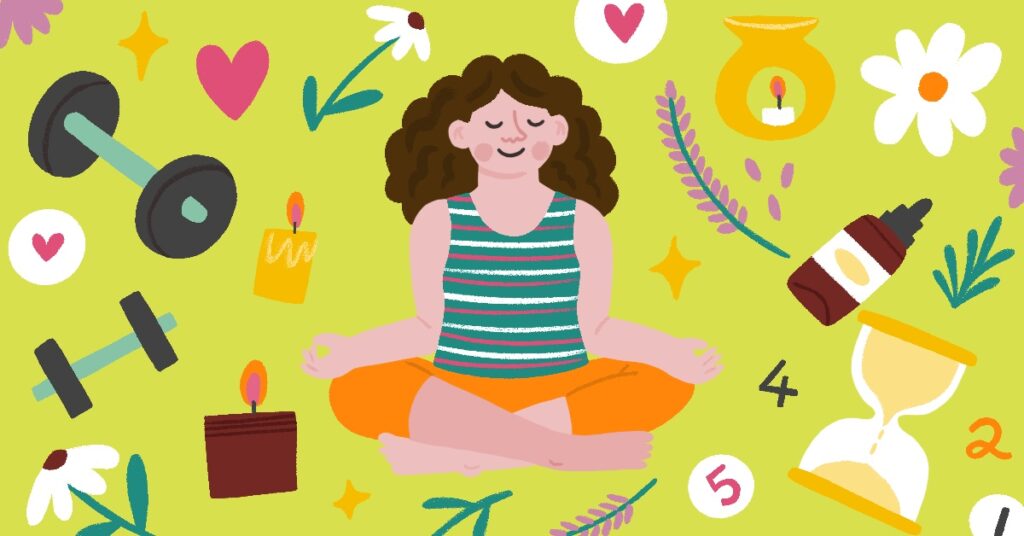
By Mary Fetzer
Medication and therapy are effective tools for managing adult ADHD symptoms, but they’re not the only options. Here are four natural ways to calm your mind and improve your focus:
1. Find Stillness and Focus With Yoga
Exercise is one of the most effective ways to alleviate ADHD symptoms. Yoga, in particular, is the bringing together of mind and body through stillness and focus. Meera Watts, founder and CEO of Siddhi Yoga, has used yoga practices to transform the lives of clients dealing with ADHD.
Yoga raises mood-boosting dopamine levels, something that is always beneficial to ADHD brains. The deep breathing and gentle pressure involved with moving through the positions leave the body both calm and energized.
“The goal is to keep your body moving in a way that is enjoyable to you,” says Watts. “Yoga is a wonderful way to relax your body and feel calm.” Adding it to your daily routine makes it a priority that can’t easily be ignored or forgotten. “And if you have the option,” says Watts, “do it outdoors for even greater benefits.” Being in nature while you move can reduce ADHD symptoms even more than exercising indoors.
2. Supplement Medication With Meditation
While physical exercise makes your body stronger, mindfulness meditation exercises make your brain stronger. ADHD impacts the part of the brain involved in impulse control, planning and focus. Meditation can benefit those parts of the brain to help you self-regulate and develop positive emotions.
Mindfulness meditation involves paying close attention to your thoughts and feelings and developing a greater awareness of what’s happening in the moment. There are five mindful exercises that can help create health mental space: mindful breathing, mindful observation, mindful awareness, mindful listening and mindful appreciation. Meditation also makes you more aware of your emotions, so you can better understand when you are reacting impulsively. The meditation sessions themselves are not the goal. Instead, you should use them as training for reaching your goal of being mindful in your daily life.
Mindfulness meditation doesn’t require a prescription or a trip to the doctor’s office. You can seek out a meditation coach, watch an online tutorial, or pair up with a friend to give it a try. Meditate while sitting, walking or eating. When you turn on your mental awareness, you’re tuning out that jumble of thoughts that can be so overwhelming. Every brain, with or without ADHD, is prone to wander. Mindfulness meditation helps you overcome that natural tendency.
3. Replace “I’ll Do It Later!” With the 5-Second Rule
One of the most common symptoms of ADHD is procrastination and avoidance of things like paying bills, calling to schedule appointments and doing tasks you aren’t interested in doing. But continually putting things off can lead to both small and large issues in life, including months of unpaid bills or years of being overdue for a dental cleaning or medical checkup.
Alena Scigliano is a clinical specialist who counsels adults struggling with ADHD. As an adult with ADHD herself, Scigliano has found that her absolute best coping skill is her personal twist on the famous Mel Robbins 5-Second Rule. “This has changed my life and that of my family and has improved many of my patients’ lives,” she says.
Here’s how the technique works: Whenever something that you need to do or take care of pops into your mind, act on it within five seconds. “Don’t bother counting,” Scigliano says. “Just don’t wait long enough for five seconds to go by.”
Here’s why the technique works: “Aside from feeling like magic,” says Scigliano, “the 5-Second Rule basically jump-starts the brain into action before your mind has enough time to talk yourself out of doing the thing you know you need to do but might not want to do.”
Scigliano has found the 5-Second Rule to be simple and life-changing. One of the worst parts of procrastinating is the anxiety that looms until you complete your task, which sometimes could be hanging around for weeks or months at a time. Getting it done right when you think about it liberates you of all unnecessary anxiety. (Learn more about organizing by reading our blogpost “Cleaning and Organizing with ADHD: A Tool to Help You Stay On Task.”)
4. Enjoy the Effects of Essential Oils
Scents like lavender make for lovely candles, and they may have the potential to calm ADHD symptoms as well.
Essential oils are extracted from plants — leaves, roots, stems, blossoms and flowers — and distilled into concentrated forms. Many believe that the active components in some essential oils improve mood. Experts think that when a person inhales the oil or applies it to the skin, a chemical message moves to the brain.
There’s no significant scientific proof that essential oils have a direct impact on the symptoms of ADHD. Still, people have used them for generations to enhance emotional well-being. People with ADHD claim that specific extracts do wonders for their symptoms:
- Vetiver oil: This essential oil is extracted from the vetiver plant in India. One study in the Journal of Intercultural Pharmacology measured the effect inhaling vetiver oil has on the brain. Measurements of brain activity showed an increase in attention levels, which can improve alertness and task performance.
- Rosemary oil: The same study suggested that the main compound in rosemary — 1,8-cineole — may help to keep the mind sharp. Subjects with a higher concentration of 1,8-cineole in the body performed better in speed and accuracy on cognitive tests. The compound is found in salvia and eucalyptus.
- Lavender: Inhaling lavender may, over time, improve sleep for people with ADHD who have trouble feeling relaxed enough to fall or stay asleep.
You can use essential oils in different ways. You can add a few drops to an aromatherapy diffuser, apply it topically (in diluted form) to the skin, add a few drops to a bath, or make a tea with whole leaves/herbs. The important point is to incorporate essential oils into your day-to-day routine and take the time to mentally and physically relax and enjoy them.
Sources:






